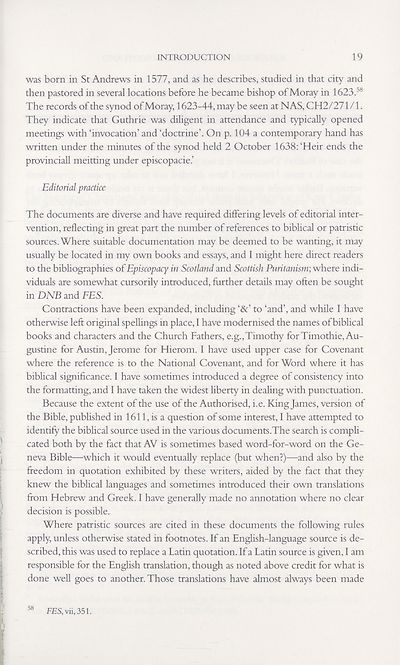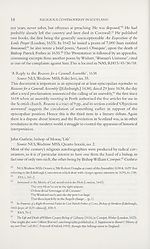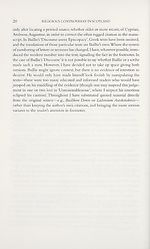Series 5 > Religious Controversy in Scotland 1625-1639
(34) Page 19
Download files
Complete book:
Individual page:
Thumbnail gallery: Grid view | List view

INTRODUCTION
19
was born in St Andrews in 1577, and as he describes, studied in that city and
then pastored in several locations before he became bishop of Moray in 1623.58
The records of the synod of Moray, 1623-44, may be seen at NAS, CH2/271 /1.
They indicate that Guthrie was dihgent in attendance and typically opened
meetings with ‘invocation’ and ‘doctrine’. On p. 104 a contemporary hand has
written under the minutes of the synod held 2 October 1638: ‘Heir ends the
provincial! meitting under episcopacie.’
Editorial practice
The documents are diverse and have required differing levels of editorial inter¬
vention, reflecting in great part the number of references to biblical or patristic
sources. Where suitable documentation may be deemed to be wanting, it may
usually be located in my own books and essays, and I might here direct readers
to the bibliographies of Episcopacy in Scotland and Scottish Puritanism; where indi¬
viduals are somewhat cursorily introduced, further details may often be sought
in DNB and FES.
Contractions have been expanded, including ‘&’ to ‘and’, and while I have
otherwise left original spellings in place, I have modernised the names of biblical
books and characters and the Church Fathers, e.g.,Timothy for Timothie, Au¬
gustine for Austin, Jerome for Hierom. I have used upper case for Covenant
where the reference is to the National Covenant, and for Word where it has
biblical significance. I have sometimes introduced a degree of consistency into
the formatting, and I have taken the widest Uberty in dealing with punctuation.
Because the extent of the use of the Authorised, i.e. King James, version of
the Bible, published in 1611, is a question of some interest, I have attempted to
identify the biblical source used in the various documents.The search is compli¬
cated both by the fact that AV is sometimes based word-for-word on the Ge¬
neva Bible—which it would eventually replace (but when?)—and also by the
freedom in quotation exhibited by these writers, aided by the fact that they
knew the biblical languages and sometimes introduced their own translations
from Hebrew and Greek. I have generally made no annotation where no clear
decision is possible.
Where patristic sources are cited in these documents the following rules
apply, unless otherwise stated in footnotes. If an English-language source is de¬
scribed, this was used to replace a Latin quotation. If a Latin source is given, I am
responsible for the English translation, though as noted above credit for what is
done well goes to another. Those translations have almost always been made
FES, vii, 351.
19
was born in St Andrews in 1577, and as he describes, studied in that city and
then pastored in several locations before he became bishop of Moray in 1623.58
The records of the synod of Moray, 1623-44, may be seen at NAS, CH2/271 /1.
They indicate that Guthrie was dihgent in attendance and typically opened
meetings with ‘invocation’ and ‘doctrine’. On p. 104 a contemporary hand has
written under the minutes of the synod held 2 October 1638: ‘Heir ends the
provincial! meitting under episcopacie.’
Editorial practice
The documents are diverse and have required differing levels of editorial inter¬
vention, reflecting in great part the number of references to biblical or patristic
sources. Where suitable documentation may be deemed to be wanting, it may
usually be located in my own books and essays, and I might here direct readers
to the bibliographies of Episcopacy in Scotland and Scottish Puritanism; where indi¬
viduals are somewhat cursorily introduced, further details may often be sought
in DNB and FES.
Contractions have been expanded, including ‘&’ to ‘and’, and while I have
otherwise left original spellings in place, I have modernised the names of biblical
books and characters and the Church Fathers, e.g.,Timothy for Timothie, Au¬
gustine for Austin, Jerome for Hierom. I have used upper case for Covenant
where the reference is to the National Covenant, and for Word where it has
biblical significance. I have sometimes introduced a degree of consistency into
the formatting, and I have taken the widest Uberty in dealing with punctuation.
Because the extent of the use of the Authorised, i.e. King James, version of
the Bible, published in 1611, is a question of some interest, I have attempted to
identify the biblical source used in the various documents.The search is compli¬
cated both by the fact that AV is sometimes based word-for-word on the Ge¬
neva Bible—which it would eventually replace (but when?)—and also by the
freedom in quotation exhibited by these writers, aided by the fact that they
knew the biblical languages and sometimes introduced their own translations
from Hebrew and Greek. I have generally made no annotation where no clear
decision is possible.
Where patristic sources are cited in these documents the following rules
apply, unless otherwise stated in footnotes. If an English-language source is de¬
scribed, this was used to replace a Latin quotation. If a Latin source is given, I am
responsible for the English translation, though as noted above credit for what is
done well goes to another. Those translations have almost always been made
FES, vii, 351.
Set display mode to:
![]() Universal Viewer |
Universal Viewer | ![]() Mirador |
Large image | Transcription
Mirador |
Large image | Transcription
Images and transcriptions on this page, including medium image downloads, may be used under the Creative Commons Attribution 4.0 International Licence unless otherwise stated. ![]()
| Scottish History Society volumes > Series 5 > Religious Controversy in Scotland 1625-1639 > (34) Page 19 |
|---|
| Permanent URL | https://digital.nls.uk/127328373 |
|---|
| Description | Over 180 volumes, published by the Scottish History Society, containing original sources on Scotland's history and people. With a wide range of subjects, the books collectively cover all periods from the 12th to 20th centuries, and reflect changing trends in Scottish history. Sources are accompanied by scholarly interpretation, references and bibliographies. Volumes are usually published annually, and more digitised volumes will be added as they become available. |
|---|


